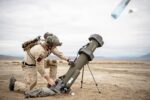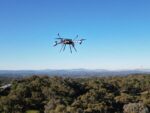In response to the escalating threat posed by small unmanned aerial systems (sUAS) and drone swarms on the modern battlefield, French airborne forces have begun operational evaluations of the PROTEUS counter-UAS system. Developed by Nexter (KNDS France), this mobile short-range air defense (SHORAD) solution centers around a 20×102 mm autocannon integrated with advanced sensors and fire control systems. The trials mark a significant step in adapting legacy firepower to meet emerging aerial threats.
PROTEUS System Overview: A Compact SHORAD Solution
The PROTEUS system is a modular counter-UAS platform designed around the Nexter ARX 20 remote weapon station (RWS), which mounts a 20 mm M621 automatic cannon firing NATO-standard 20×102 mm ammunition. Originally intended for light armored vehicles and naval platforms, the M621 offers high accuracy and rate of fire—up to 750 rounds per minute—making it suitable for engaging fast-moving aerial targets like quadcopters and fixed-wing drones.
Mounted on a lightweight trailer or tactical vehicle such as a P4 or VLRA truck chassis, PROTEUS is designed for rapid deployment with airborne or light infantry units. The system includes:
- ARX 20 RWS with day/night electro-optical targeting
- Ballistic computer with automatic target tracking
- Laser rangefinder and thermal imaging
- Optional radar cueing integration
- Manual or remote operation modes
This configuration allows operators to detect, track, and engage Class I UAVs (under 150 kg) at ranges up to approximately 1.5–2 km depending on target profile and munition type.
Tactical Trials with French Paratroopers
The recent trials were conducted by elements of the French Army’s airborne brigade—likely the 11e Brigade Parachutiste—during field exercises simulating drone swarm attacks on forward operating bases. According to open-source imagery and defense media reports from October 2025, PROTEUS was deployed in conjunction with man-portable air defense systems (MANPADS) such as Mistral missiles and electronic warfare jammers.
The focus of these trials was to evaluate:
- Target acquisition speed against low-signature drones
- Ammunition effectiveness against rotary-wing micro-UAVs
- Integration into platoon-level C2 networks for layered air defense
- Shoot-on-the-move feasibility from light vehicles
The results reportedly demonstrated effective suppression of small drone swarms under realistic combat conditions. However, limitations in engagement range and sensor resolution were noted—particularly under cluttered urban or forested environments where line-of-sight is constrained.
The Growing Threat of Drone Swarms in Tactical Environments
The emergence of low-cost commercial drones repurposed for ISR or attack roles has dramatically shifted tactical air defense requirements. Conflicts such as Ukraine have shown how FPV kamikaze drones can overwhelm static defenses through saturation tactics.
France’s military doctrine recognizes this shift. In its latest “SCORPION” modernization program documents, the French Army emphasizes decentralized counter-UAS capabilities at company level or below. Systems like PROTEUS are meant to fill this gap between MANPADS—which are expensive per shot—and soft-kill EW tools that may be ineffective against autonomous drones operating without GNSS links.
NATO allies are similarly investing in kinetic C-UAS solutions using autocannons or programmable airburst munitions (e.g., Germany’s Skyranger 30). In this context, France’s development of an expeditionary gun-based system tailored for light forces reflects both doctrinal adaptation and industrial agility via Nexter’s modular weapons portfolio.
Ammunition Considerations: HEI vs Airburst vs Tracer Loads
The effectiveness of gun-based C-UAS platforms hinges not only on fire control but also ammunition selection. The M621 cannon used in PROTEUS can fire various NATO-standard rounds including:
- HEI-T (High Explosive Incendiary – Tracer): Effective against plastic-bodied drones via fragmentation/incendiary effect; useful for visual spotting during daytime engagements.
- SAPHEI: Semi-armor piercing variant useful if drones are reinforced or carry payloads inside hardened shells.
- AIRBURST programmable munitions: Not yet confirmed for use with ARX-20 but would significantly increase kill probability against swarm formations; under development within KNDS ecosystem.
A key limitation remains magazine capacity—typically limited to ~100 rounds per feed box—which could constrain sustained engagements unless reload drills are optimized under combat conditions.
Nexter’s Role and Future Roadmap for Mobile C-UAS Systems
Nexter has positioned itself as a key player in Europe’s evolving C-UAS landscape through its scalable weapon stations like ARX-25/30 and integration experience across land platforms. While PROTEUS is currently focused on kinetic defeat using direct-fire guns, future variants may incorporate multi-sensor fusion with radar cueing (e.g., Thales Ground Observer series), soft-kill modules like RF jammers or directed energy weapons (DEW), or even loitering munition interceptors.
The company has not yet disclosed export customers but has reportedly demonstrated variants of the ARX-20 RWS at Eurosatory and other international shows since 2022. Given rising interest from NATO eastern flank countries facing persistent UAV threats from Russian-origin systems like Lancet or Orlan-10 types, demand for mobile SHORAD/C-UAS hybrids is expected to grow through late decade procurement cycles.
Operational Implications for Light Forces in Contested Airspace
The deployment of PROTEUS reflects broader trends toward distributed air defense architectures where every platoon becomes part of an integrated kill chain against aerial threats—including those flying below radar coverage thresholds. For airborne units lacking heavy armor or fixed IADS coverage, having organic kinetic C-UAS capability is increasingly vital not just for force protection but also freedom of maneuver during expeditionary operations.
If adopted widely across French rapid reaction forces—including Foreign Legion elements—it could significantly enhance survivability during initial entry phases before heavier assets arrive. Lessons learned from these trials will likely influence future iterations involving improved sensors, faster slew rates, automated detection/classification algorithms using AI/ML techniques—and perhaps even networked cueing from overhead ISR assets feeding into battle management systems like SICS (Système d’Information du Combat Scorpion).










